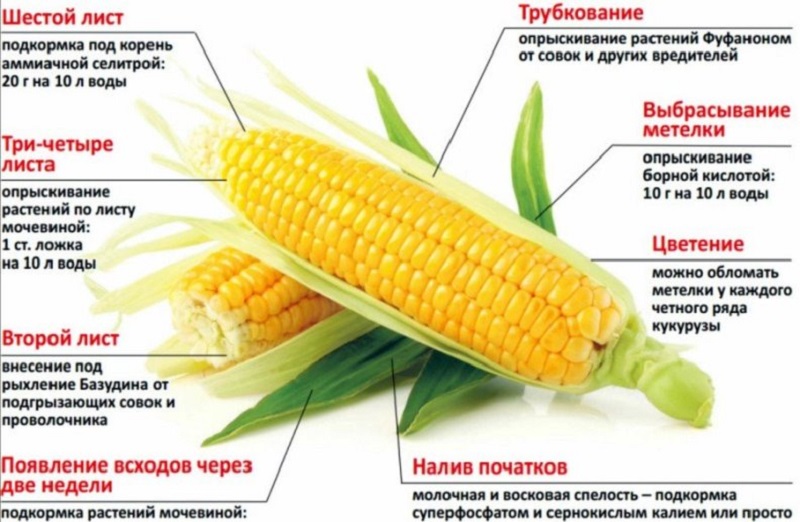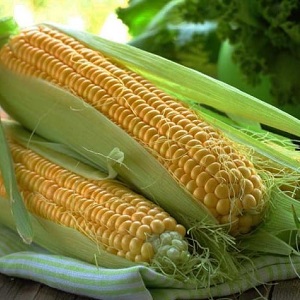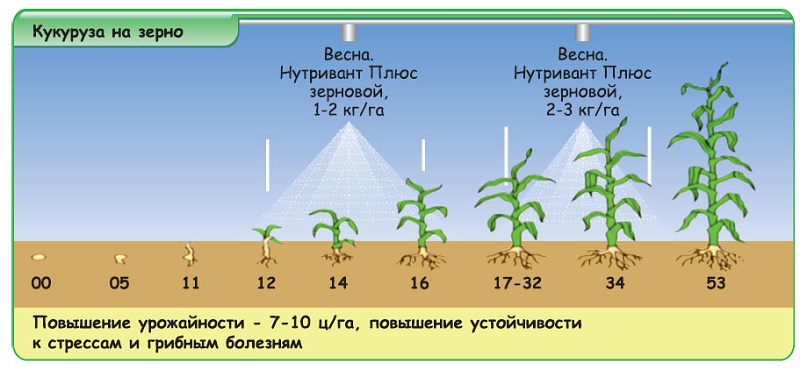How and what to feed corn: the best formulations and rules for their introduction to get a rich harvest
Corn is a thermophilic crop, so many gardeners believe that it should be grown only in the southern regions of our country. But this is not the case. Thanks to proper care and timely feeding, the plant can be grown even in a country house in central Russia.
How to feed corn for growth in the country, what fertilizers to use to get a rich harvest - we will figure it out in the article.
The content of the article
The importance of fertilizing corn
To provide corn intensive growth and fruiting, you need to take care of timely and high-quality feeding.
Since corn is a demanding heat-loving plant, the gardener will have to make sure that the temperature, acidity and moisture of the soil correspond to the parameters necessary for the full growth and development of the plant.
Why do you need feeding
The amount of nutrients in top dressing depends on the phase of culture development.
 The main elements required for the growth of corn:
The main elements required for the growth of corn:
- nitrogen;
- potassium;
- phosphorus;
- calcium;
- magnesium;
- zinc;
- boron;
- copper.
Nitrogen affects corn yields. Potassium increases drought resistance, has a positive effect on the grain that forms on the cob. Phosphorus is involved in the formation of the root system, photosynthesis and plant respiration.
With a lack of calcium, yield decreases. If corn lacks boron, it will flower less well. Zinc is involved in the growth process and increases the frost resistance of the plant.
therefore it is important to choose the right feeding, which would provide the plant with all the substances and trace elements it needs.
The best fertilizer for corn
For feeding corn it is recommended to use different types of fertilizers: mineral and organic.

Organic fertilizers
If there is a shortage of organic matter in the soil, the corn stalk becomes thin and light, and a crust can be seen around on the ground.
The best organic fertilizer for corn is manure... Root feeding is carried out with this organic substance when the sprouts have already sprouted. Most often, gardeners use liquid manure for fertilization - it is diluted with water in a ratio of 1:50 and watered at the rate of 10 liters of water per 1 m².
Another option for the preparation of fertilizer: 10 kg of manure is dissolved in 50 liters of water and insisted in a dark place for 5 days. After the solution is diluted in water in a ratio of 1: 1 and the plant is watered.
Reference. The application of manure in the amount of 30 kg can increase the yield up to 10 centners per hectare.
Chicken manure contains trace elements essential for corn: phosphorus, nitrogen, calcium, magnesium, potassium. For 10 m², 5 buckets of chicken manure are used. After application, the yield increases by one and a half times.
Mineral dressing
Mineral fertilizers affect yields and help the plant adapt to cold weather conditions.
They are divided into 2 types: complex and one-component (potash, nitrogen, phosphorus).
Potash fertilizers
 Potash top dressing affects the distribution of water in the plant... With a deficiency of this substance, corn loses its ability to withstand drought, the stems sink to the ground.
Potash top dressing affects the distribution of water in the plant... With a deficiency of this substance, corn loses its ability to withstand drought, the stems sink to the ground.
Potassium increases yields and palatability, while reducing stress caused by bad weather.
Potash application period depends on the type of soil: Sandy soil needs fertilization in the spring and clay soil in the fall.
Attention! A good fertilizer option is potash salt. It is brought in when the corn has 6-7 leaves. 0.5 kg of the substance is used per 1 hectare of land.
Nitrogen fertilizers
The volume and raw material properties of the crop depend on the nitrogen content in the soil.
Ammonium nitrate is one of the best nitrogen fertilizers... It is brought into the soil 2 times. Half of the norm - in the spring for plowing, the second half - in the summer as plant nutrition.
In summer, feeding is carried out when the first 5 leaves have appeared on the plant, then when the cobs have formed on the corn. With a nitrogen deficiency, the leaves become yellow and pale, thinner. Foliar feeding is also carried out with an ammonia solution - the leaves are sprayed.
Important! Do not overuse nitrogen fertilizers. Its excess can negatively affect the plant - the amount of nitrates will increase and the dry matter content in grains will decrease.
Phosphate fertilizers
Phosphate fertilizers applied to the soil before sowing... Phosphorus increases the cold resistance of the plant and accelerates the ripening of the ears.

Superphosphate and ammophos are used: 8-12 kg of the substance is applied per 1 ha.
It can be useful:
How to deal with the most dangerous pests and diseases of corn
What fertilizer is best applied when planting
What is the best fertilizer for sowing? Novice gardeners are often interested in this question.
Corn does not like soil with a high concentration of minerals... Therefore, organic matter is preferred before planting. In autumn or spring, compost is applied: 0.5 buckets per 1 m².
To increase the amount of the crop, urea (100 g per 10 m²) can be added to the soil in spring.
For grain corn
Top dressing of corn for grain is carried out several times per season... When planting grain, only mineral fertilizers are applied.
First of all, corn needs phosphorus. Superphosphate is applied in small doses: 10 kg per 1 hectare to a depth of 3 cm.

For table corn
The first root dressing is carried out after 5-6 sheets appeared. It is better at this stage to use complex fertilizers with a high nitrogen content.
The second time the corn is fertilized before the initial phase of regrowth of the flower panicle.... You can use mineral and organic fertilizers (manure, herbal infusion).
Foliar top dressing in the form of spraying is also usedwhen the plant has 5-6 leaves, the second - after 10 days. Spraying can be done with magnesium sulfate solution. Plants are sprayed no more than 4 times during the growing season with an interval of 1-2 weeks.
Top dressing of corn by month
In June, fertilize with fertilizers containing nitrogen, since this time is characterized by active plant growth. You can use nitrophosphate, ammonia water.

In July, nitrogen fertilization of corn with urea is repeated... Additionally, root and foliar feeding is used, depending on the state of the plant.
Special attention should be paid to feeding corn in Augustsince the ears ripen this month. Top dressing will affect the taste and juiciness of the fruit. During this period, mineral and organic fertilizers are used.
Tips and tricks from experienced summer residents
To get a rich harvest follow simple rules:
- Apply mineral dressing evenly to the soil by irrigation. In the soil, substances do not spread, but it is necessary that all roots receive uniform nutrition.
- Water the soil well before feeding.
- Monitor the dosage of corn feed. It is better to apply less fertilizer than more. With an excess of nutrients, there will be an intensive set of green mass, but the ears will become smaller.
- Do not use several types of fertilizer at once.Some substances are incompatible with each other.
Read also:
Delicious and sweet corn variety "Bonduelle"
Conclusion
Corn is a demanding and capricious plant. Before planting, study the properties of the soil and use only those substances that are lacking.
Do not apply too much mineral fertilizer. Corn does not like it when they are contained in the soil in excess.